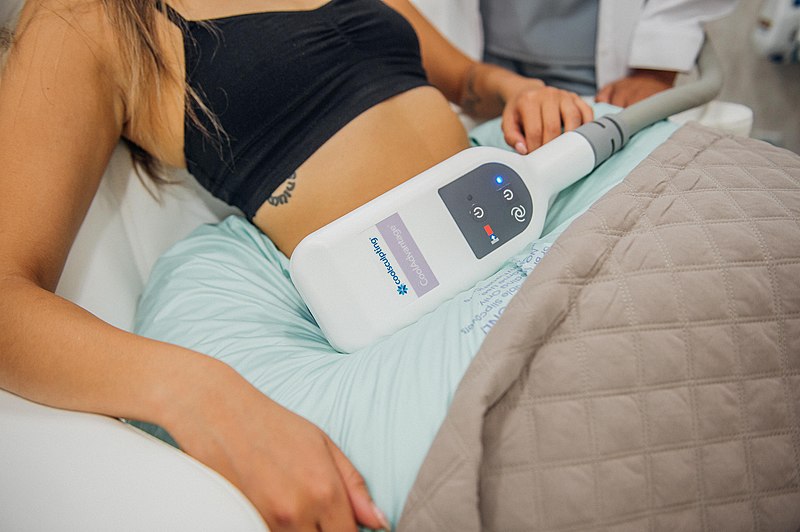Studies reveal that coolsculpting is an efficient procedure for fact reduction. The procedure is nonsurgical and non-invasive that assists with removing extra fat cells from under the skin. Since it is non-invasive, it poses various advantages over standard surgical fat removal treatments. The popularity of coolsculpting is growing in the United States. It is FDA approved since 2010 and has increased by a whopping 823 percent since then.
What Is CoolSculpting?
The technique of employing freezing temperatures to kill fat cells that are just beneath the skin’s surface is known as cryolipolysis (the name gives it away: “cryo” stands for cold, “lipo” for fat, and “lysis” stands for “destruction”).
Despite the fact that the word “CoolSculpting” is frequently used to describe the cryolipolysis procedure, it is really the name of a particular medical instrument. Most often, a doctor, nurse, or physician assistant performs the process; however, certain medical spa staff members are also qualified to do CoolSculpting. For additional information on who is certified to do the surgery, contact your state’s medical board.
How Does Coolsculpting Work?
The process is carried out through a procedure called cryolilpolysis. It is effective by placing a fat roll between two panels that cools the fat to freezing temperatures. Researchers established that cryolipolyisis lowered the treated fat layer by up to twenty-five percent. The results still existed within six months after the treatment. Dead, frozen fat cells are expelled from the body through the liver after several weeks, presenting full fat loss results within three months. Some individuals who opt for coolsculpting procedure choose to treat various part of the body, usually:
- Lower back
- Belly
- Thighs
- Sides
Coolsculpting can also be effective in reducing the appearance of cellulite on the buttocks, arms, and legs. Some people also have the procedure done to lower the excess fat found under their skin. It takes approximately an hour to treat each body part. Treatment of more body parts necessitates additional coolsculpting treatments to attain results. More significant body parts might also necessitate more procedures than the smaller body parts. You can also view this post about at home coolsculpting.
CoolSculpting Risks
Cryolipolysis may be performed at your doctor’s office, and there is no need to plan for recuperation time. Driving oneself home after the appointment is OK.
A few negative consequences exist. Throughout the process, you may feel pulling or tugging on your skin as well as intense cold. You can feel sore and like you just did some exercise afterward. You could a little swelling as well.
Rarely, minor to moderate discomfort might follow cryolipolysis. Another rare possibility is feeling pain in the nerves.
Your skin may occasionally appear less smooth afterward. Paradoxical fat hyperplasia is a rare complication that affects less than 1% of patients who undergo the procedure. As a result, the quantity of fat cells in the treated area increases rather than decreases.
Probable Side Effects Of Coolsculpting:
- A tugging feeling is experienced at treatment sites once the doctor places a fat roll between the cooling panels.
- Patients can experience sensations of pain, aching, or stinging at treatment sites for two weeks after undergoing treatment that usually goes away on its own without any additional treatment.
- Individuals may also have short-term swelling, redness, bruising, and skin sensitivity at the treatment sites.
- In a few rare cases, coolsculpting can result in an increase in the number of fat cells in body parts that were treated. The cause for this is unknown, but it happens more commonly in men than women. This occurs in less than one percent trusted source of cases. While scarce, it is worth knowing of such a probable side effect. Most individuals, who experienced this effect referred to as paradoxical adipose hyperplasia opted to pursue other fat removal procedures, like traditional liposuction.
Who Are Typical Candidates That Coolsculpting Can Work For?
It should be mentioned that coolsculpting is not an effective treatment for obesity. This technique is suitable for people who want to eliminate a small amount of additional fat resistant to alternative weight-loss attempts like exercise and diet. Coolsculpting is considered an effective and safe treatment for lessening body fat in many individuals. However, for some individuals, this is not a treatment to choose. People with the following health conditions should not opt for this procedure due to the risk of dangerous complications. Such conditions include:
- Cold agglutinin disease
- Cryoglobulinemia
- Paroxysmal cold hemoglobinuria (PCH)
Whether or not you suffer from these conditions, it is essential to liaise with your doctor first before making arrangements to have the procedure done or doing coolsculpting at home.
Cost of CoolSculpting
The average cost of coolsculpting’s procedure is between $2,000 and $4,000. However, tiny applicator-required regions like the chin and jaw may cost between $700 and 900. Noninvasive fat reduction operations cost $1,437 on average across the US.
The size of the region to be treated determines how much the therapy will cost, as will the number of treatments required.
It seems sensible for someone to think about how many treatments will be required. Greater treatments could be necessary for areas with greater fat. The cost may also be influenced by elements including the treatment provider’s expertise and geographic location.
Insurance usually does not pay the price of CoolSculpting since it is a cosmetic surgery and does not address an underlying medical problem.
Results
Areas with resistant fat can be efficiently removed using CoolSculpting. The body gets rid of the frozen and decomposing fat tissues after 4-6 months.
Additionally, the process yields long-lasting consequences. Since it eliminates fat cells, they will not grow back.
How long is CoolSculpting effective?
With CoolSculpting, the fat cells are eliminated, so they cannot regrow. Effects may last for six to nine years.
Even after the destruction of the old fat cells, new ones can still develop. For this reason, maintaining a healthy lifestyle is essential to keeping the effects of CoolSculpting. If a person does not exercise or maintain a healthy diet, fat may start to accumulate once more.
What happens during each session and how many are required?
The target area and goals of a person will determine how many sessions they can have. People, however, often need one to three treatments for each location. The skin and fat of a specific region are suctioned between the applicators during a session. The fat cells will be destroyed by these applicators as they cool.
Benefits of Getting the CoolSculpting Treatment
Burning off fat in 60 minutes
Only one treatment session is needed per target location, and it only takes about an hour. The tissue between the cooling panels is drawn in by the applicator cup, which creates a little vacuum pressure that you can feel. The treated region will become numb after cooling. The region will then receive a light massage.
Observable changes in 2 to 3 weeks
In only one session, CoolSculpting may reduce fat by an average of 22.4%, according to clinical research. A change could become apparent as soon as two to three weeks.
Safe and no downtime
There is no downtime following this non-invasive fat freezing procedure in the Philippines. It has been confirmed safe in addition to being effective thanks to US FDA clearance.
Alternatives to CoolSculpting
Cryolipolysis is just one form of fat reduction technique.
Liposuction vs CoolSculpting
Liposuction could be a preferable choice for folks who desire more immediate benefits from a single procedure. However, there is a far higher likelihood of issues with liposuction than with cryolipolysis since it requires more involvement.
Kybella vs. CoolSculpting
A branded version of injectable lipolysis is Kybella. An injection is utilized to get rid of chin fat or submental fat.
While Kybella is minimally invasive, CoolSculpting is not. In addition to potentially damaging surrounding tissues, Kybella may also slightly injure the mandibular nerve, which might lead to dysphagia (problems swallowing) and an asymmetrical grin.
SculpSure vs. CoolSculpting
Another non-invasive approach to fat removal is SculpSure. It uses a heat-based laser or laser lipolysis to “melt” fat cells.
SculpSure treatments, which last an average of 25 minutes, are shorter than CoolSculpting sessions and may treat several locations simultaneously. The downtime, intensity of discomfort, side effects, and possible hazards of the two treatments are comparable.
Vanquish vs. CoolSculpting
Vanquish is a kind of radiofrequency lipolysis that uses radio waves to break up fat cells. Body mass index (BMI), abdominal circumference, and body fat are successfully reduced with Vanquish.
How to Find a Provider of CoolSculpting
Although CoolSculpting is available in nonclinical settings like medical spas, it is imperative that you consult a qualified medical expert if you are thinking about having the process done. Find a board-certified dermatologist or cosmetic surgeon; they will be knowledgeable about a wide range of surgeries and treatments and can assist you in determining whether CoolSculpting is a good choice for you. Both the American Board of Cosmetic Surgery and the American Academy of Dermatology provide searchable directories of skilled medical professionals nearby. In other words, just because medical spas are providing the service does not always imply the staff members are qualified to do so.
Another word of caution: Practitioners who are untrained in a variety of fat-loss treatments may exaggerate the capabilities of the instruments they have at their disposal. This may appeal to patients who are apprehensive about having more invasive operations.


